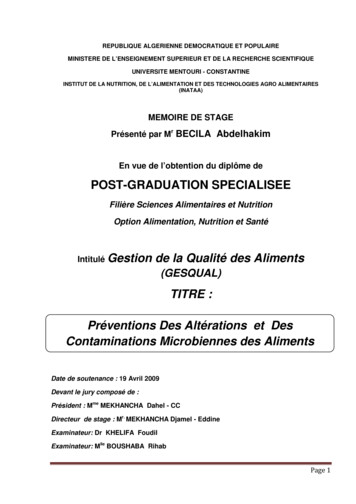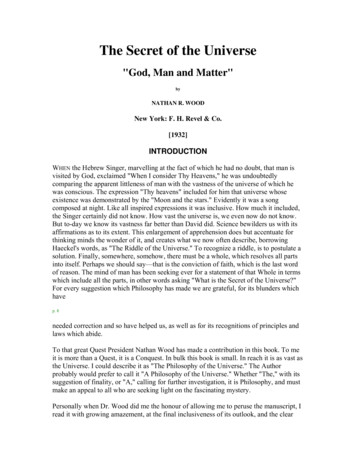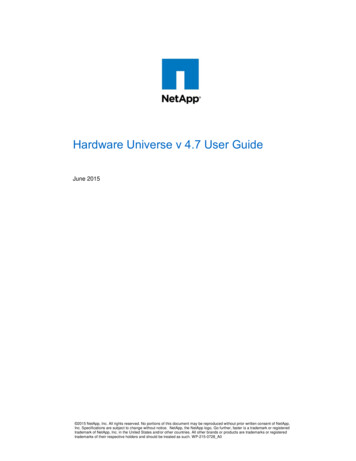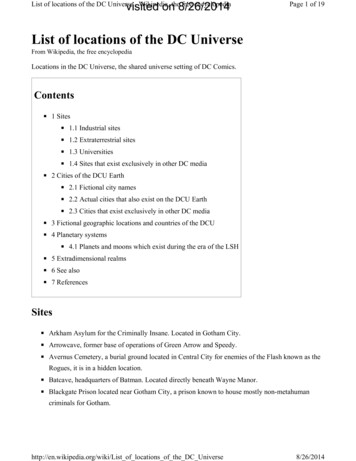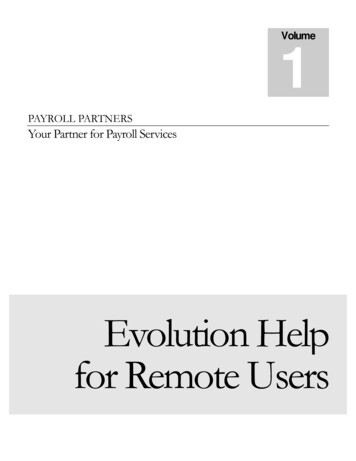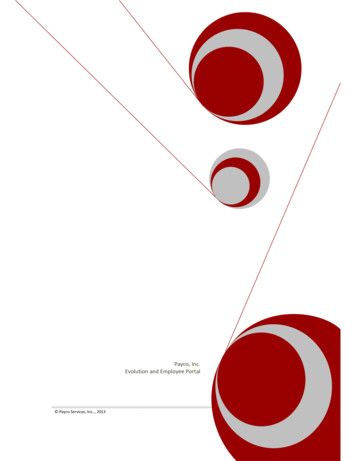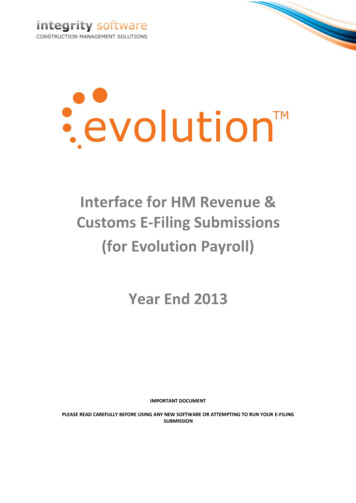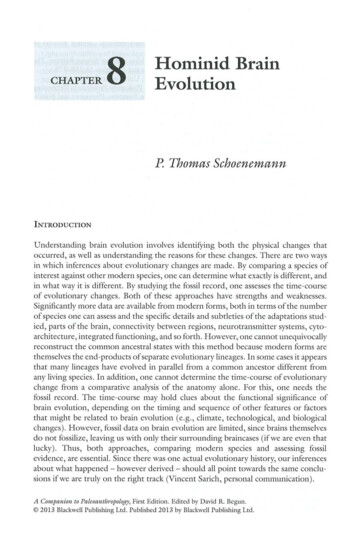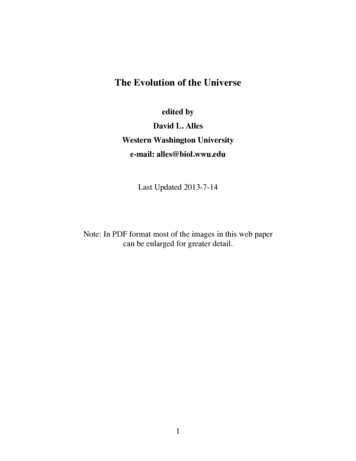
Transcription
The Evolution of the Universeedited byDavid L. AllesWestern Washington Universitye-mail: alles@biol.wwu.eduLast Updated 2013-7-14Note: In PDF format most of the images in this web papercan be enlarged for greater detail.1
“If being educated means having an informed sense of timeand place, then it is essential for a person to be familiar with thescientific aspects of the universe and know something of itsorigin and structure.”Project 2061, American Association for the Advancement of Science---------------------------"The effort to understand the universe is one of the veryfew things that lifts human life a little above the level of farce,and gives it some of the grace of tragedy."—Steven WeinbergSteven Weinberg is winner of the Nobel Prize in Physics in 1979,and author of the book "The First Three Minutes".2
IntroductionScience at the beginning of the twenty-first century can make some bold,yet simple observations:1) the universe has evolved;2) we are a result of that evolution.“We are the first generation of human beings to glimpse the sweep ofcosmic history, from the universe's fiery origin in the Big Bang to thesilent, stately flight of galaxies through the intergalactic night.” (NationalResearch Council)Order in the UniverseCosmology is the study of the evolution of the universe from its first moments to thepresent. In cosmology the most fundamental question we can ask is: Does our universe haveintelligible regularities that we can understand—is it ordered? This question lies at the heart ofthe scientific revolution beginning in the sixteenth century. That revolution began with thediscoveries by Copernicus, Galileo, and Newton of order in our world. Today our scientificunderstanding of nature’s order has reached a critical threshold. Only now can we begin topiece together a coherent picture of the whole. Only now can we begin to see the deep order ofour universe.“The evolution of the world can be compared to a display of fireworks that hasjust ended; some few red wisps, ashes and smoke. Standing on a cooled cinder, wesee the slow fading of the suns, and we try to recall the vanishing brilliance of theorigin of the worlds.” —Abbé Georges LemaîtreWe now understand the order in our world by using the standard Hot Big Bang model ofthe evolution of the universe. The four key observational successes of the model are:The Expansion of the UniverseNucleosynthesis of the light elementsOrigin of the cosmic background radiationFormation of galaxies and large-scale structureThe Big Bang model makes accurate and scientifically testable hypotheses in each of theseareas, and the remarkable agreement with the observational data gives us considerableconfidence in the model.3
Lemaître with EinsteinAbbé Georges Edouard Lemaître (1894 -1966) was a Belgian astrophysicist and Priestwho developed an evolving cosmological model which indicated that the universe had begunin a "Big Bang."Einstein's theory of general relativity, announced in 1916, had led to variouscosmological models, including Einstein's own model of a static universe. Lemaître in 1927(and, independently, Alexander Friedmann in 1922) discovered a family of solutions toEinstein's field equations of relativity that described not a static but an expanding universe.This idea of an expanding universe was demonstrated experimentally in 1929 by EdwinHubble who was unaware of the work of Lemaître and Friedmann. Lemaître's model of theuniverse received little notice until Eddington arranged for it to be translated and reprinted in1931. It was not only the idea of an expanding universe which was so important in Lemaître'swork, on which others were soon working, but also his attempt to think of the cause andbeginning of the expansion.If matter is everywhere receding, it would seem natural to suppose that in the distantpast it was closer together. If we go far enough back, argued Lemaître, we reach the "primalatom", a time at which the entire universe was in an extremely compact and compressed state.He spoke of some instability being produced by radioactive decay of the primal atom that wassufficient to cause an immense explosion that initiated the expansion.4
George Gamow (1904-1968)Lemaître's Big-Bang model did not fit well with the available time scales of the 1930s.Nor did he provide enough mathematical detail to attract serious cosmologists. Its importancetoday is due more to the revival and revision it received at the hands of George Gamow andRalph Alpher in 1948.Web Reference for George Gamow:http://en.wikipedia.org/wiki/George GamowFor an excellent history of the development of the Big Bang theory see:Big Bang: The Origin of the Universe by Simon Singh p?storyId 45054145
The Expansion of the Universe (1993)As bizarre as it may seem, space itself is expanding—specifically, the vast regions ofspace between galaxies. According to Einstein, space is not simply emptiness; it's a real,stretchable, flexible thing. The notion that space is expanding is a prediction of Einstein'stheory of gravity, which describes a simple but universal relationship between space, time, andmatter.In the late 1920's, the astronomer Edwin Hubble first observed that distant galaxies aremoving away from us, just as would be expected if the space between galaxies were growingin volume and just as predicted by Einstein's theory of gravity. Since then, astronomers havemeasured this recession for millions of galaxies.6
Galaxy NGC 3370, a spiral galaxy like our own Milky WayThe galaxies sit more or less passively in the space around them. As the space betweengalaxies expands, it carries the galaxies further apart—like raisins in an expanding dough.However, the universe is a chaotic place and the gravity from one galaxy, or from a group ofgalaxies, may disturb the motion of its near neighbors, causing them to collide. But on average,when you compare two large enough chunks of space, the galaxies in one are moving awayfrom the galaxies in the other. Amazingly, space is not actually expanding "into" anything. Putanother way, a given region of space doesn't actually "push" the rest of the universe out of theway as it expands.Web Referencehttp://apod.nasa.gov/apod/ap030911.html7
(The following essay is from the Universe Forum produced for NASA by the HarvardSmithsonian Center for Astrophysics in 2004.)The Big Bang “Theory”The Big Bang is actually not a "theory" at all, but rather a scenario or model about theearly moments of our universe, for which the evidence is overwhelming.It is a common misconception that the Big Bang was the origin of the universe. Inreality, the Big Bang scenario is completely silent about how the universe came into existencein the first place. In fact, the closer we look to time "zero," the less certain we are about whatactually happened, because our current description of physical laws do not yet apply to suchextremes of nature. The Big Bang scenario simply assumes that space, time, and energyalready existed. But it tells us nothing about where they came from or why the universe wasborn hot and dense to begin with.But if space and everything with it is expanding now, then the universe must have beenmuch denser in the past. That is, all the matter and energy (such as light) that we observe in theuniverse would have been compressed into a much smaller space in the past. Einstein's theoryof gravity enables us to run the "movie" of the universe backwards—i.e., to calculate thedensity that the universe must have had in the past. The result: any chunk of the universe wecan observe—no matter how large—must have expanded from an infinitesimally small volumeof space.By determining how fast the universe is expanding now, and then "running the movie ofthe universe" backwards in time, we can determine the age of the universe. The result is thatspace started expanding 13.77 billion years ago. This number has now been experimentallydetermined to within 1% accuracy.It's a common misconception that the entire universe began from a point. If the wholeuniverse is infinitely large today (and we don't know yet), then it would have been infinitelylarge in the past, including during the Big Bang. But any finite chunk of the universe—such asthe part of the universe we can observe today—is predicted to have started from an extremelysmall volume.Part of the confusion is that scientists sometimes use the term "universe" when they'rereferring to just the part we can see "the observable universe". And sometimes they use theterm universe to refer to everything, including the part of the universe beyond what we can see.It's also a common misconception that the Big Bang was an "explosion" that took placesomewhere in space. But the Big Bang was an expansion of space itself. Every part of spaceparticipated in it. For example, the part of space occupied by the Earth, the Sun, and our MilkyWay galaxy was once, during the Big Bang, incredibly hot and dense.8
The same holds true of every other part of the universe we can see. We observe thatgalaxies are rushing apart in just the way predicted by the Big Bang model. But there are otherimportant observations that support the Big Bang.Astronomers have detected, throughout the universe, two chemical elements that couldonly have been created during the Big Bang: hydrogen and helium. Furthermore, theseelements are observed in just the proportions (roughly 75% hydrogen, 25% helium) predictedto have been produced during the Big Bang. This is the nucleosynthesis of the light elements.This prediction is based on our well-established understanding of nuclear reactions—independent of Einstein's theory of gravity.Second, we can actually detect the light left over from the era of the Big Bang. This isthe origin of the cosmic microwave background radiation. The blinding light that waspresent in our region of space has long since traveled off to the far reaches of the universe. Butlight from distant parts of the universe is just now arriving here at Earth, billions of years afterthe Big Bang. This light is observed to have all the characteristics expected from the Big Bangscenario and from our understanding of heat and light.The standard Hot Big Bang model also provides a framework in which to understandthe collapse of matter to form galaxies and other large-scale structures observed in theUniverse today. At about 10,000 years after the Big Bang, the temperature had fallen to suchan extent that the energy density of the Universe began to be dominated by massive particles,rather than the light and other radiation which had predominated earlier. This change in theform of matter density meant that the gravitational forces between the massive particles couldbegin to take effect, so that any small perturbations in their density would grow. Thirteen pointeight billion years later we see the results of this collapse in the structure and distribution of thegalaxies.Web Referencehttp://cfa-www.harvard.edu/seuforum/9
The Observable UniverseThe best estimate of the age of the universe as of 2013 is 13.798 0.037 billion yearsbut due to the expansion of space humans are observing objects that were originally muchcloser but are now considerably farther away (as defined in terms of cosmological properdistance, which is equal to the co-moving distance at the present time) than a static 13.8 billionlight-years distance. The diameter of the observable universe is estimated at about 93 billionlight-years (28 billion parsecs), putting the edge of the observable universe at about 46–47billion light-years away.Web Referencehttp://en.wikipedia.org/wiki/Observable universe10
The observable universe is a spherical volume of space.The co-moving distance from Earth to the edge of the "visible" universe (also called theparticle horizon) is about 46.5 billion light-years in any direction. This defines a lower limit onthe co-moving radius of the "observable" universe, although it is expected that the visibleuniverse is somewhat smaller than the observable universe since we see only light from thecosmic microwave background radiation that was emitted after the time of recombination,giving us the spherical surface of last scattering. The visible universe is thus a sphere with adiameter of about 93 billion light-years.11
The Hubble Space Telescope 1996Web releases/1996/01/background/12
The Hubble Deep Field (HDF) 1996Web le Deep Field13
Hubble Ultra Deep Field DiagramThe Hubble Deep Field visible-light (HDF), released in 1996, looked back to within 1.0billion years after the Big Bang. The Hubble Ultra Deep Field visible-light (HUDF), releasedMarch 2004, looks back even further to a time only 0.7 billion years after the Big Bang, closeto the period when the first galaxies formed.HUDF Image Credits: NASA, ESA, S. Beckwith (STScI) and the HUDF TeamWeb References for HUDF leases/2004/07/image/j/14
Hubble Ultra Deep Field (HUDF) 2004This Hubble Ultra Deep Field (HUDF) view of nearly 10,000 galaxies was the deepestvisible-light image of the cosmos in 2004. This galaxy-studded view of the Hubble Ultra DeepField represents a "deep" core sample of the universe, cutting across billions of light-years.HUDF is an image of a small region of space in the constellation Fornax, composited fromHubble Space Telescope data accumulated over a period from September 3, 2003 throughJanuary 16, 2004. The patch of sky in which the galaxies reside was chosen because it had alow density of bright stars in the near-field.15
In vibrant contrast to the rich harvest of classic spiral and elliptical galaxies, there isalso a zoo of oddball galaxies littering the field, as shown in this close-up view of the HUDF.Some look like toothpicks; others like links on a bracelet. A few appear to be interacting.These oddball galaxies chronicle a period when the universe was younger and more chaotic.Order and structure were just beginning to emerge.HUDF 2004 References:http://en.wikipedia.org/wiki/Hubble Ultra-Deep ases/2004/07/image/e/16
Dawn of the Galaxies: HUDF Infrared 2009When did galaxies form? To find out, the deepest near-infrared image of the sky ever,has been taken of the same field as the optical-light Hubble Ultra Deep Field (HUDF) in 2004.This image was taken the summer of 2009, by the newly installed Wide Field Camera 3 onthe refurbished Hubble Space Telescope. Faint red smudges identified on this image likelysurpass redshift 8 in distance. These galaxies, therefore, likely existed when the universe wasonly a few percent of its present age, and may well be members of the first class of galaxies.This early class of low luminosity galaxies likely contained energetic stars emitting light thattransformed much of the remaining normal matter in the universe from a cold gas to a hotionized plasma. Some large modern galaxies make a colorful foreground to these distantgalaxies.Web Reference: http://antwrp.gsfc.nasa.gov/apod/ap091209.html17
The Hubble eXtreme Deep Field 2012The Hubble eXtreme Deep Field (XDF) is an image of a small part of space in thecenter of the Hubble Ultra Deep Field within the constellation Fornax, showing the deepestoptical view in space. Released on September 25, 2012, the XDF image compiled 10 years ofprevious images and shows galaxies from 13.2 billion years ago. The exposure time was twomillion seconds, or approximately 23 days. The faintest galaxies are one ten-billionth thebrightness of what the human eye can see. Many of the smaller galaxies are very younggalaxies that eventually became the major galaxies, like the Milky Way and other galaxies inour galactic neighborhood.Web Referencehttp://en.wikipedia.org/wiki/Hubble Extreme Deep Field18
This illustration separates the XDF into three planes showing foreground, background,and very far background galaxies. These divisions reflect different epochs in the evolvinguniverse. Fully mature galaxies are in the foreground plane that shows galaxies as they lookedless than 5 billion years ago. The universe is rich in evolving, nearly mature galaxies from 5 to9 billion years ago. Beyond 9 billion years the universe is awash in compact galaxies andproto-galaxies, blazing with young stars.Web releases/2012/37/image/d/19
From the Dark Age to StarbrustStellar 'Fireworks Finale' Came First in the Young Universe—subsequent analysisof Hubble Space Telescope deep sky images supported the theory that the first stars in theuniverse appeared in an abrupt eruption of star formation, rather than at a gradual pace. Theuniverse could go on making stars for trillions of years to come, before all the hydrogen is usedup, or is too diffuse to coalesce. But the universe will never again resemble the star-studdedtapestry that brought light to the darkness.Web releases/2002/02/image/b/20
The End of the Dark AgeThis is an artist's impression of how the very early universe might have looked when itwent through a voracious onset of star formation, converting primordial hydrogen into myriadstars at an unprecedented rate. Back then the sky would have looked markedly different fromthe sea of quiescent galaxies around us today. This sky is ablaze with primeval starburstgalaxies; giant elliptical and spiral galaxies have yet to form. Within the starburst galaxies,bright knots of hot blue stars come and go like bursting fireworks shells. The most massivestars self-detonate as supernovas, which explode across the sky like a string of firecrackers.The foreground starburst galaxies at the lower right are sculpted with hot bubbles fromsupernova explosions and torrential stellar winds.Web releases/2002/02/image/a/21
The Early Cosmos: Out of the DarknessAlthough no stars and galaxies existed just after the Big Bang, the young cosmos wasanything but dull. It was humming with activity. In the beginning, physical conditions were soextreme that matter as we know it today did not exist.During the early part of its existence, after one times ten to the minus 12th of a second,our universe was so small and dense that light and matter intertwined; space was hot, dark, andionized—filled with a plasma of charged particles. By the time the universe was one secondold, the temperatures and densities had dropped enough for protons and neutrons to form fromquarks. Within the next few minutes, the nuclei of the light elements, hydrogen, helium, andlithium, were created in a process called primal or Big Bang nucleosynthesis. The universe atthis point was cooling rapidly enough to shut off the process of nucleosynthesis beforeelements heavier than boron could form.About four hundred thousand years after the Big Bang the cosmos had grown largeenough for matter and energy to move through space without immediately colliding—endingthe plasma state of the early universe. The universe had cooled to about 3,000 degrees Celsius(5,400 degrees Fahrenheit) allowing electrons, protons, and neutrons to come together to formneutral atoms—the basic building blocks of all visible matter in the universe. This marked the“Decoupling” of matter and energy that we detect today as the cosmic microwavebackground radiation. This radiation has been stretched and cooled by the expansion of theuniverse from three thousand degrees to minus 270.42 degrees Celsius, or just three degreesabove absolute zero.At this point the universe was made up mostly of clouds of hydrogen and helium atoms.As the universe expanded and cooled, some regions of space amassed slightly higher densitiesof hydrogen. As millions of years passed, the slight differences grew large, as dense areas drewin material because they had more gravity. Researchers have dubbed this period of coalescingthe "Dark Ages."Web Referencehttp://en.wikipedia.org/wiki/Cosmic microwave background radiation22
Penzias and Wilson at the Holmdel Horn Antenna, New Jersey in 1964In 1964, while using the horn antenna, Penzias and Wilson stumbled on the microwavebackground radiation that permeates the universe. Cosmologists quickly realized that Penziasand Wilson had made the most important discovery in modern astronomy since Edwin Hubbledemonstrated in the 1920s that the universe was expanding. This discovery provided theevidence that confirmed George Gamow's and Abbe Georges Lemaitre's "Big Bang" theory ofthe creation of the universe and forever changed the science of cosmology from a field forunlimited theoretical speculation into a subject disciplined by direct observation.Web php?storyId 465551723
Dr. Robert Wilson (left) and Dr. Arno Penzias (right) 1975in front of the Holmdel Horn Antenna, Crawford Hill, N.J. (Photo Credit: Bell Labs)In 1978, Penzias and Wilson received the Nobel Prize for Physics for their momentousdiscovery.Web Referencehttp://map.gsfc.nasa.gov/universe/bb tests cmb.html24
An artist's concept of the COBE satellite in Earth orbit in 1989.Web mages.html25
COBE All-Sky Map 1992The Cosmic Background Explorer (COBE) satellite was launched in 1989, twentyfive years after the discovery of the microwave background radiation in 1964. In 1992, theCOBE team announced that they had discovered “ripples at the edge of the universe”, that is,the first sign of primordial fluctuations at 380,000 years after the Big Bang. These are theimprint of the seeds of galaxy formation. These appear as temperature variations on the full skymap that COBE obtained (shown above). Red areas represent areas with slightly highertemperatures and blue areas a slightly lower temperature than the mean.Web res/cobe 20th.htmlIn 2006, two American astronomers, John C. Mather of the NASA Goddard SpaceFlight Center in Greenbelt, Md., and George F. Smoot of the Lawrence Berkeley NationalLaboratory at the University of California, Berkeley, won the Nobel Prize in Physics for theirwork on the COBE project.26
Wilkinson Microwave Anisotropy Probe (WMAP) SatelliteThe WMAP mission was proposed to NASA in 1995 and launched in 2001.Web ory.html27
WMAP Spacecraft with the Earth, Moon, and Sun in the background.The final command to stop collecting data was transmitted to the WMAP satellite onAugust 19th 2010.28
WMAP All-Sky Map 2003Analyses of a high-resolution map released in 2003, of microwave light emitted only380,000 years after the Big Bang (pictured above) appear to define our universe more preciselythan ever before. The results from the orbiting Wilkinson Microwave Anisotropy Proberesolve several long-standing disagreements in cosmology rooted in less precise data.Specifically, present analyses of the WMAP all-sky map indicate that the universe is 13.7billion years old (accurate to 1 percent), composed of 74 percent "dark energy", 22 percentcold "dark matter", and only 4 percent atoms, is currently expanding at the rate of 71km/sec/Mpc (accurate to 5 percent), and underwent an episode of rapid expansion called"inflation".Web ges.html29
WMAP All-Sky Map 2012-9 yearThe universe is 13.73 billion years old, give or take 120 million years, astronomersannounced in early March 2008. That age, based on precision measurements of the oldest lightin the universe, agrees with results announced in 2006. Two additional years of data from aNASA's Wilkinson Microwave Anisotropy Probe have narrowed the uncertainty by tens ofmillions of years (Chang, 2008).About 380,000 years after the Big Bang, the universe cooled enough for protons andelectrons to combine into hydrogen atoms. That released a burst of light, which over thebillions of years since has cooled to a bath of microwaves pervading the cosmos. Yet there areslight variations in the background, which the NASA satellite had been measuring since 2001.Those variations have given evidence supporting an idea known as cosmic inflation, a rapidexpansion of the universe in the first trillionth of a trillionth of a second of its existence. Thenew set of data was precise enough to differentiate between various proposed models ofinflation. Astronomers can also now see strong evidence for the universe being awash inalmost mass-less subatomic particles known as neutrinos. This sea of primordial neutrinoscreated in the Big Bang was expected.The new data also refined findings that the earliest stars switched on 400 million yearsafter the Big Bang. The starlight started breaking up interstellar hydrogen atoms back intocharged protons and electrons—creating a fog that deflected the cosmic microwaves—but tookhalf a billion years to break apart all of the atoms.Web ges.html30
38 Years of Studying the CMBThis image allows a comparison of the resolution of the Holmdel Horn Antenna in1965, to COBE in 1992, to WMAP in 2003, a time span of 38 years. The vague light across thehorn antenna view of the CMB and the red streaks across COBE and WMAP are light from theMilky Way.Web ges.html31
WMAP 2012-9 year Time Line of the UniverseThe expansion of the universe over most of its history has been relatively gradual. Thenotion that a rapid period "inflation" preceded the Big Bang expansion was first put forth 25years ago by Alan Guth. The new WMAP observations favor specific inflation scenarios overother long held ideas.Web dex.htmlFor more on the development of "inflation" theory see:http://en.wikipedia.org/wiki/Alan Guth32
WMAP data from 2008 revealed that the universe's contents include 4.6% atoms, thebuilding blocks of stars and planets. Dark matter comprised 23% of the universe. Thismatter, different from atoms, does not emit or absorb light. It has only been detected indirectlyby its gravity. And that 72% of the universe is composed of "dark energy" that acts as asort of anti-gravity. This energy, distinct from dark matter, is responsible for the present-dayacceleration of the universal expansion. WMAP data is accurate to two digits, so the total ofthese numbers is not 100%. This reflects the limit of WMAP's ability to define Dark Matterand Dark Energy.33
Fritz Zwicky and Dark Matter"Most of us think of the universe as all the matter there is, and by matter we mean thestuff we can see from afar or could touch if it were up close. But the motion of the observableobjects in the universe, like stars and galaxies and clouds of gas, make no sense if the universecontains only ordinary, perceptible matter. This became apparent in 1933, thanks to anastronomer named Fritz Zwicky.He discovered that parts of a distant cluster of galaxies were moving too fast to remainwithin the cluster if it contained only ordinary matter. He concluded that "dark matter", aphrase he coined, held the cluster together. But for 70-plus years since, no one had observeddark matter. It would be like seeing gravity. That has now changed."34
Dark Evidence:A composite image depicting normal matter (pink) and gravity (blue) showsdark matter's presence in the "bullet cluster" of galaxies (2006).Astronomers using ground-based telescopes and satellite observatories have witnessed aseparation between visible matter and the dark matter that shapes its motions (see above). Itoccurred 100 million years ago when two galaxy clusters three billion light-years away passedthrough each other at about 10 million miles an hour.Imagine two crowds of pedestrians on a collision course. Some people in both groups—no doubt dressed in black—basically refuse to engage with anyone and just keep moving. Butthe ordinary people want to stop and chat. As the two crowds merge and then head in oppositedirections, the people in black will have pushed ahead, separating themselves from the rest.That, in a nutshell, is what the astronomers saw, minus the people, of course.35
Observing what was predicted a lifetime ago is an extraordinary accomplishment. Itconfirms that this part of our picture of the universe is essentially correct. But observing darkmatter and knowing what it is are very different, and we are nowhere near the latter.The matter in galaxy cluster 1E 0657-56, known as the "bullet cluster", is shown in thecomposite image on the previous page. The bullet cluster's individual galaxies are seen in theoptical image data, but their total mass adds up to far less than the mass of the cluster's twoclouds of hot x-ray emitting gas shown in red. Representing even more mass than the opticalgalaxies and x-ray gas combined, the blue hues show the distribution of dark matter in thecluster.Otherwise invisible to telescopic views, the dark matter was mapped by observations ofgravitational lensing of background galaxies. In a text book example of a shock front, thebullet-shaped cloud of gas at the right was distorted during the titanic collision between twogalaxy clusters that created the larger bullet cluster itself. But the dark matter present has notinteracted with the cluster gas except by gravity. The clear separation of dark matter and gasclouds is considered direct evidence that dark matter exists.Web .htmlReference:Seigried, Tom (2006). Satellite's X-ray Vision Clinches the Case for Dark Matter. Science,313(Aug 25), 1033.Credits:Composite Image Credits: X-ray: NASA/CXC/CfA/ M. Markevitch et al.Lensing Map: NASA/STScI; ESO WFI; Magellan/U. Arizon
Jul 14, 2013 · space started expanding 13.77 billion years ago. This number has now been experimentally determined to within 1% accuracy. It's a common misconception that the entire universe began from a point. If the whole universe is infinitely large today (and we don't know yet), then it would have be
